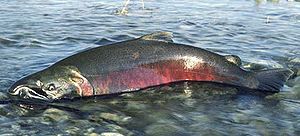 Image via Wikipedia
Image via Wikipedia
(Juneau) – The Alaska Department of Fish and Game (ADF&G) is closely monitoring and evaluating a recent report that samples taken from sockeye salmon in British Columbia show exposure to Infectious Salmon Anemia Virus (ISAv). The test results, reported by researchers from Simon Fraser University, are based on a very limited sample of sockeye salmon smolts from Rivers Inlet in central B.C. The smolts were not exhibiting any outward signs of infection.
Research on ISAv indicates that the risk to Alaska’s salmon stocks is low. Pacific salmon have been shown to be mostly resistant to ISAv, which is a flu-like disease of Atlantic salmon. ISAv does not transmit to humans and is not a human health or food safety issue.
“Right now, there is a lot of misinformation out there about this finding and this disease,” said Dr. Ted Meyers, ADF&G Fisheries Scientist. “The Rivers Inlet results are being analyzed through additional testing in a second laboratory to rule out any false positives. At this point we are concerned, but do not want to over react as we await more definitive information from Canada.”
Live Atlantic salmon are not allowed to be imported into Alaska. However, if the virus is confirmed present in B.C. migratory Pacific salmon or the Atlantic salmon stocks prevalent in B.C. fish farms, there is concern over potential impacts to Alaska salmon stocks.
“The department’s pathology lab is in contact with agencies in Canada and will continue monitoring the situation,” said Cora Campbell, Commissioner, Alaska Department of Fish and Game. “We will take all necessary measures to protect our stocks.”
Additional information on ISAv and the reports from B.C. can be found on the ADF&G web site athttp://www.adfg.alaska.gov/index.cfm?adfg=pressreleases.isav_info. The department will keep Alaskans informed as additional information becomes available.

No comments:
Post a Comment